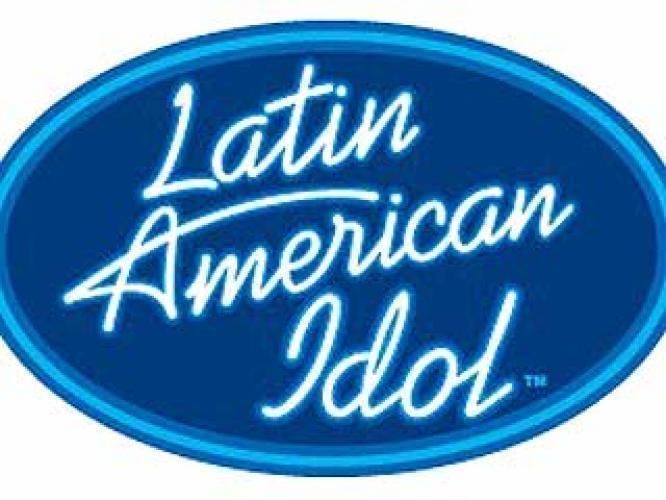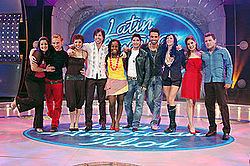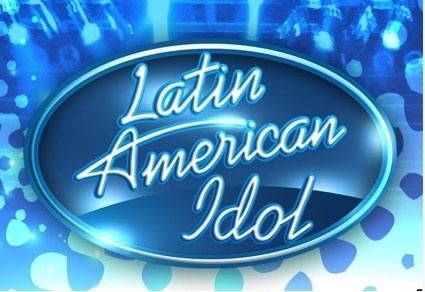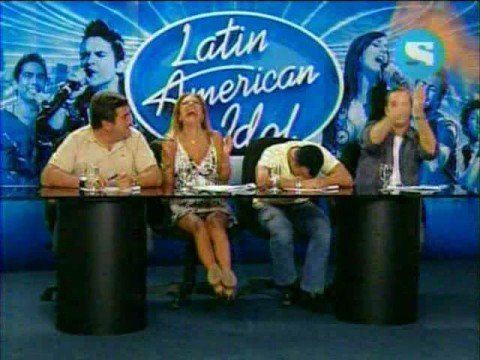5 /10 1 Votes5
Original network SET Program creator Simon Fuller | 4.9/10 IMDb No. of seasons 4 First episode date 22 April 2006 | |||||||||||||||||||||||||||||||||
 | ||||||||||||||||||||||||||||||||||
Starring Erika de la Vega (Season 1-4)Monchi Balestra (Season 1-Season 3)Jon Secada (Season 1-4)Mimi (Season 2-4)Gustavo Sánchez (Season 1-Season 3)Oscar Mediavilla (Season 4) Original release April 22, 2006 – December 8, 2009 Genres Reality television, Game show, Interactive television Similar American Idol, Pop Idol, Canadian Idol, The X Factor (US), American Juniors | ||||||||||||||||||||||||||||||||||
Latin american idol 2008 nicole pillman
Latin American Idol was the Spanish American edition of the popular British franchise of Idols, well known for its American version American Idol. The show aimed to discover the pop idol of the Latin American region. The show was filmed in Buenos Aires and was transmitted to over 23 nations in the region via the Sony Entertainment Television network.
Contents
- Latin american idol 2008 nicole pillman
- Latin american idol 4ta temporada casting venezuela miercoles 16 de sept 2009 parte 2
- Premise
- Auditions
- Theatersecond stage of auditions
- Season 1
- Seasons 2 and 3
- Season 4
- Seasons 1 2 and 3
- Concerts
- First season
- Second season
- References

Latin american idol 4ta temporada casting venezuela miercoles 16 de sept 2009 parte 2
Premise

Latin American Idol was filmed in Buenos Aires, Argentina and aired throughout Latin America with the exception of Brazil, which has its own version called Ídolos Brazil, premiered in 2006. Portuguese-language contestants can participate if they are able to sing in Spanish. The show's hosts are the Venezuelan Erika de La Vega and Argentine Monchi Balestra. In the first season the judges panel was made up by Jon Secada from the United States (born in Cuba), Gustavo Sánchez from Puerto Rico and Elizabeth Meza from México, the last of this being replaced since the second season by Mimi, a former member of musical group Flans, and Oscar Mediavilla from Argentina, replacing Gustavo Sánchez for the fourth season.
This show is divided into four phases: auditions, theater/secondary audition stage, workshops and performances.
Auditions

The first season’s auditions took place in order in the cities of Caracas, Venezuela; Bogotá, Colombia; Mexico City, México; and finally in Buenos Aires. Auditions took place between April–May, 2006. In the show's third season, Panama City, Panamá was chosen as the fifth audition city, while in the fourth season San José, Costa Rica was chosen as an audition venue.
The stage of auditions was divided into two rounds:

Theater/second stage of auditions
After performing for the panel of judges, successful contestants are invited to the next round of competition in Argentina.
Season 1
The first season was different to the subsequent ones because this was divided just into two rounds.
The theater stage was divided into two rounds:
Seasons 2 and 3
The theater stage is divided into three rounds, that will be explained in-depth each one.
Season 4
The theater phase is renamed the "Second stage of auditions" during the fourth season.
Seasons 1, 2 and 3
The thirty semi-finalists are split up into three groups of ten semi-finalists each one. The workshops consist of a small stage in which there is a small amount of public and each one of the semi-finalists perform in front of a live studio audience. During the workshops, each contestant performs in a platform, after talking about him or herself in previously recorded video. In the first season contestants performed accompanied by a pianist. During subsequent seasons, a live band performed with the contestant.
In this stage there are 4 workshops. In three of them the public vote is necessary and one special that is fully based on the judges decision. Each group of ten of the 30 semifinalists make one of three first workshops (Of which each contestant was put randomly). The last workshop is the Wild Card show, in which is performed the people who are saved from the judges in the workshops.
In a usual workshop, each one of the semi-finalists performs in a platform singing any kind of song in Spanish of any kind. Before the semi-finalist performs, a video takes place to let viewers get to know better each one of the semi-finalists. During the performance, a small advertisement is shown up with the name and last name of the contestants and below it will show the name we should text and the telephone number to which we have to send the text message to vote for that person. Generally, the name that we have to text is the first name of the semi-finalist, in such a case that two or more of the 30 semi-finalists have the same name, we will have to text the last name of each one to vote. In so special cases people will have to text the nickname in text messages to vote for the semi-finalists, but this is so strange to happen. After finishing the performance, the judges express their opinion about the performance. When the workshop finishes, the voting lines get open. The public starts voting and the next day the results show of each workshop takes place. In this results show, the public decision is revealed. The top three semi-finalists become finalists. After the LatinAmerica's decision is revealed, the judges rescue two of the seven semi-finalists that were not chosen by the public to participate in the last workshop, the Wild Card.
Because there are three workshops, 9 semifinalists go to the finals with the public's help. Latin American Idol's normal format shows that there should be just 10 finalists (This has just been fulfilled in the first season). Two people who are rescued from each workshop make 6 semi-finalists totally to participate en the Wild Card, from which the panel of judges just choose one of them. In the second and third season, there has been an irregularity in Wild Cards, because in the third workshop of each season, the panel of judges rescued surprisingly one contestant more of each workshop to participate in Wild Card. In the Wild Card, the panel of judges chose three semi-finalists to make them become finalists. Because of this irregularity, the second and third season have had twelve finalists instead of just ten. The semi-finalists who achieve to become finalists, will always keep the same name to make people vote for them.
Season 4
In the fourth season, the workshops decreased, instead of making 4, there were made just 2. Because in the "second stage of elimination" there are 20 contestants chosen, of which 10 are male and 10 are female. Each Workshop es for one sex. The first workshop is for male and the second one is for female. In each workshop there are chosen the top 5 based on the public's vote. Also as expected, the panel of judges rescue contestants. In each workshop the panel of judges can choose one semi-finalist who has not received enough votes to become a finalist. Therefore, at the end of this stage, we find 12 finalists as in last seasons. It is important to point out that this new method is used so that doesn't occur what happened in seasons 2 and 3. In the second season, male dominated the amount of finalists (9 to 3) and in the third season, female dominated it (7 to 5). This season as the first season will have an equity about the finalists sex.
Concerts
During the first season, the number of contestants in the final stage (concerts' stage) was with 10 contestants, however, for the second season and the third season, because of the high quality of the finalists in these last ones, the panel of judges and production took the decision of increasing the number of people to the concerts to 12 finalists. In the fourth season it was assimilated that there would be 12 finalists.
According to the Latin American Idol's normal format this stage should be made in nine concerts. This has been fulfilled to the letter despite there have been more finalists than what was planned.
In the last stage, the panel of judges have no persuasion in the elimination of contestants. Everything that is worthing for elimination is the public's vote, the panel of judges just express their opinions in the performances.
The final stage is divided into nine concerts. Each concert has two episodes: one for performances and the other one for the results show. In each day of the performances of the concert, each finalist performs a song chosen by him/herself depending on the corresponding theme in each concert. Just after finishing the performances the voting starts, so Latin America has approximately 15 hours to vote for their favorite contestant. When starts the results show the next day the voting is ended and one or more finalist is eliminated. Because there have been more finalists of what was expected in the last three seasons, the production has had to fit the first concerts. In the second and fourth season, two finalists were eliminated in the first two concerts. In the third season three finalists were eliminated in the first concert. Each concert has a theme, and each one of the finalists should perform with a song according to the theme. While the finalist performs there will appear the name of the finalist and below the instructions of how to vote for the finalist. In Argentina and Uruguay is kept the number 35355 (In the workshops, people had to vote to this same number). In the rest of Latin America people have to text to 43657 (IDOLS) and in Puerto Rico because of being a territory of the United States is obtained a special number, 55225. At the middle of this stage when several finalists have been eliminated, in the sixth concert, with the last five finalists; the finalists will have to perform with two songs per concert until the semifinal (eighth concert), which usually has no theme. When there are the three last finalists, who are considered semi-finalists of the concerts' stage (In the third season there was an irregularity with this kind of semi-finalists because there were four of them because in the antepenultimate concert any contestant was eliminated, subsequently this irregularity was sorted out by eliminating two contestants in the semi-final). These four semi-finalists of the concerts' stage, just after the results show of the seventh concert finishes, are sent with a group of the production of Latin American Idol to their respective countries. There the production record everything the finalists do in their countries, besides sending with them to the singer mentors to prepare them for the semi-final concert. In the semi-final concert, the finalists sing two songs and as regularly one is eliminated or in such a case of the third season two are eliminated. The two ones remaining, become finalists of the concerts' stage. And one of them will be the winner of the season.
The final concert of Latin American Idol is the ninth concert and is different to the previous ones. Because there are just two finalists, each one has to sing three songs. The last concert has no theme. The show's production write two songs fully unpublished so that the finalists sing them in this concert. In the first round of this concert a finalist sing an unpublished song and the other finalist sing the other song. In the second round each finalist sing their best performance during all their way for Latin American Idol. In the third round each finalist sing the unpublished song that didn't sing in the first round. The results show of this last concert is called the great final because in this one is decided who is the new Latin American Idol. The great final is the largest episode of the season because the auditions and the two parts of the theater last one hour on air. The results show last a half-hour, but the great final lasts two hours and is the last episode that is completely live in air. In the great final perform the finalists of the season, and there is a great quantity of guest celebrities. When finishing the show it is decided who the winner is based on the publics' vote and gets a contract with Sony BMG.
First season
The first season of Latin American Idol premiered on July 12, 2004. Its official sponsor was Movistar. There were 4 auditions: México City, México; Bogotá, Colombia; Caracas, Venezuela and of course it the host country, Argentina in its capital Buenos Aires. The hosts were: Erika De la Vega and Monchi Balestra. The judges were: Jon Secada, Gustavo Sánchez and Elizabeth Meza. Before starting the judges of American Idol; Simon Cowell, Randy Jackson and Paula Abdul performed in Sony Entertainment Television a video saying that there was coming a Latin American version of the show.
The theater of this stage is unique making a comparison with the other seasons because this one was divided into 2 stages instead of three. On August 2, the making of the First Workshop was made, were the finalists were chosen: Gabriel Suárez, Lilia Mariñelarena and Mayré Martínez. On August 9, 2007 the second workshop, in which the ones who went to the next stage were Isa Mosquera, Dennis Smith and Andrea del Valle. On August 17, the last threesome of finalists chosen was revealed: Efraín Medina, Hernán López and Noelia Soto. Of each one of the workshops, two contestants were saved, who made it to the group of the last workshop that was known as The last opportunity. The saved contestant in this last workshop was John Paul Ospina, who joined the other nine contestants thanks to the help the panel of judges gave him to be part of group of the finalists. John Paul Ospina turned into the first Wild Card of Latin American Idol and also is the only one in getting the workshop of the last chance without surprises of choosing more finalists.
In the next stage it was made what was called "galas" in which each contestant sang a song and were voted by the public, the 3 contestants with the fewest votes were called to the "Bottom 3" and one of them was eliminated, while the other ones were mentioned randomly. In the second stage they were calling a "Bottom 2", it means 2 contestants with the fewest votes, and each contestant sang two songs per concert. After the two stages of the galas it was got to the semifinal membered by Mayré Martínez from Venezuela, Noelia Soto from Argentina and Efraín Medina from México, resulting eliminated the Mexican contestant, which made finalists to the Venezuelan Mayré Martínez and the argentinian Noelia Soto, at the end of the season, each finalist sang three (3) themes, two unpublished and their favorite sang in the competition, the voting was spread out to twenty-four (24) hours, having the Venezuelan Mayré Martínez, winner of the competition, and the only contestant who wasn't proposed to be eliminated. In declarations subsequent to the final, the judge Gustavo Sánchez announced that Mayré had received 76.5% of the total votes.
Second season
In the second season, the Mexican judge Elizabeth Meza left the competition giving place to Irma Angélica "Mimí" Hernández, another Mexican judge. Movistar returned as a sponsor its support to the show. The autitions kept same way (Bogotá, Colombia; Mexico City, México; Caracas, Venezuela and Buenos Aires, Argentina) ad the contestants, Venezuelan Erika De la Vega and argentinian Monchi Balestra. Rules changed so that people under 18 years old could participate, the competition came down to 16 years old. The competition also increased the ages from 28 to 30 years old.
The theater changed radically compared to the first season, instead of two rounds, it was developed in three rounds: auditions in lines, duets and solo performances. The judged gave some songs to make contestants choose what they want to sing in their duets and solo performances. The panel of judges grouped in the duets rounds each contestant. When the theater round finished, the LatinAmerica's top 30 was chosen.
The three workshops was started by the Latin American public voting. And were chosen 9 out of the 10 finalists that were planned to be chosen, in the first three workshops. In these, the two first finalists from CentroAmerica were chosen in the competition; Carlos Peña from Guatemala and Arquímedes Reyes from El Salvador. Also the panel of judges chose the first finalists under age of the competition, Francisco Pérez from Colombia and Emiliano Sansone from Argentina. For the first time in the competition, the judges just chose one female contestant of the three first workshops, Silvia de Freitas from Venezuela. In the third workshop many were taken surprisingly because the judges and the production improvisily decided to save more people and three finalists more were chosen in the Wildcard show instead of just one. Which made 12 finalists. In this workshop the first finalist from Caribe, Rosángela Abreu from Puerto Rico made it to the finals. In this workshop made it to the next stage two female and one male, leaving nine male finalists and three female finalists.
When the 12 finalists were selected, the concerts' stage started. In the first and second concert 2 contestants with the fewest votes were eliminated, since the third show just one contestant was being eliminated, all this is because this stage should be made just in nice concerts. Incredibly the argentinian contestants who had 4 representatives among the finalists were eliminated quickly: two in the first concert, one in the second and the last one in the third. In the semifinal there were Rosangela Abreu, Ricardo Caballero and Carlos Peña. In the final show, after a great musical show and the exceptional performance of the two finalists, it was revealed that Carlos Peña from Guatemala was the winner, it's important to mention that Peña was the only contestant who was about to be eliminated, because he was never in any bottom.. This season was characterized by the intention of the production of the show to penetrate more in the Mexican market.
